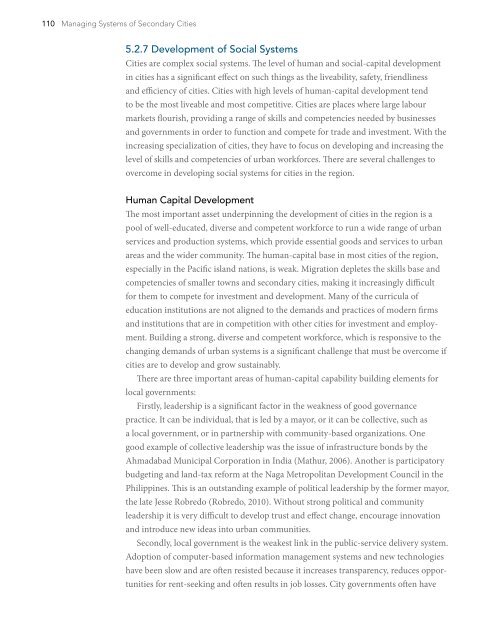DYhWN
DYhWN
DYhWN
You also want an ePaper? Increase the reach of your titles
YUMPU automatically turns print PDFs into web optimized ePapers that Google loves.
110 Managing Systems of Secondary Cities5.2.7 Development of Social SystemsCities are complex social systems. The level of human and social-capital developmentin cities has a significant effect on such things as the liveability, safety, friendlinessand efficiency of cities. Cities with high levels of human-capital development tendto be the most liveable and most competitive. Cities are places where large labourmarkets flourish, providing a range of skills and competencies needed by businessesand governments in order to function and compete for trade and investment. With theincreasing specialization of cities, they have to focus on developing and increasing thelevel of skills and competencies of urban workforces. There are several challenges toovercome in developing social systems for cities in the region.Human Capital DevelopmentThe most important asset underpinning the development of cities in the region is apool of well-educated, diverse and competent workforce to run a wide range of urbanservices and production systems, which provide essential goods and services to urbanareas and the wider community. The human-capital base in most cities of the region,especially in the Pacific island nations, is weak. Migration depletes the skills base andcompetencies of smaller towns and secondary cities, making it increasingly difficultfor them to compete for investment and development. Many of the curricula ofeducation institutions are not aligned to the demands and practices of modern firmsand institutions that are in competition with other cities for investment and employment.Building a strong, diverse and competent workforce, which is responsive to thechanging demands of urban systems is a significant challenge that must be overcome ifcities are to develop and grow sustainably.There are three important areas of human-capital capability building elements forlocal governments:Firstly, leadership is a significant factor in the weakness of good governancepractice. It can be individual, that is led by a mayor, or it can be collective, such asa local government, or in partnership with community-based organizations. Onegood example of collective leadership was the issue of infrastructure bonds by theAhmadabad Municipal Corporation in India (Mathur, 2006). Another is participatorybudgeting and land-tax reform at the Naga Metropolitan Development Council in thePhilippines. This is an outstanding example of political leadership by the former mayor,the late Jesse Robredo (Robredo, 2010). Without strong political and communityleadership it is very difficult to develop trust and effect change, encourage innovationand introduce new ideas into urban communities.Secondly, local government is the weakest link in the public-service delivery system.Adoption of computer-based information management systems and new technologieshave been slow and are often resisted because it increases transparency, reduces opportunitiesfor rent-seeking and often results in job losses. City governments often have


